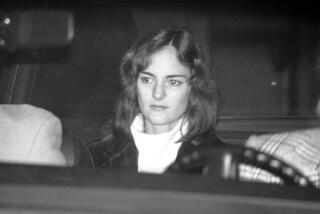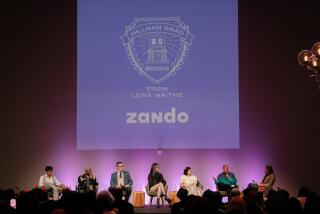The Rediscovery of Zora Neale Hurston
- Share via
NEW YORK — She died a pauper, buried in an unmarked grave. In a literary lifetime that included novels, essays, short stories and plays, Zora Neale Hurston earned less than $1,000 in royalties.
“But by the quality and quantity of her work, she is probably the major undiscovered writer of the 20th Century,” N.Y. Nathiri, who has studied Hurston’s work, said.
Thirty years after her death at age 69 in a Fort Pierce, Fla., nursing home in 1960, Hurston has attained the celebrity status that eluded her in life. In her hometown of Eatonville, Fla., an annual Zora Neale Hurston Festival of the Arts honors her. She has been inducted into the Florida Artists’ Hall of Fame. Eatonville, about five miles outside Orlando, was incorporated in 1887 as the country’s first African-American town.
A 114-page retrospective that features photographs, interviews with her family and an essay by Alice Walker was published this year by Orlando’s Sentinel Books, and nearly 50 years after their original publication and 30 years after Hurston’s death, HarperCollins is in the process of reissuing all of Hurston’s works. Four novels published in 1990 began the HarperCollins reissue; one, “Their Eyes Were Watching God,” sold more than 170,000 copies its first year.
The appeal of Hurston’s work, said Bill Shinker, publisher and executive vice president of HarperCollins, is “One, she is an extraordinary writer. She writes in a very naturalistic style. She uses the language of the people, the idiom.” But also, Shinker said, “She is talking about part of the (African-American) experience that is in many ways not that well known.”
With the character of Janie Crawford, “Their Eyes Were Watching God,” Hurston’s best-known novel, “established the archetype of the woman who wants to be recognized as her own person,” said Nathiri, the executive director of the Assn. to Preserve the Eatonville Community Inc., sponsor of the annual Hurston festival of the arts.
Hurston, said Nathiri, “was so far ahead of her time.” About 60 years ago, for example, Hurston “would pack off and go to Central America, or to Jamaica, to do field research, when no one was doing something like this, and certainly not a woman.”
Hurston graduated from high school in her 20s, and did not graduate from college until her late 20s or early 30s, Nathiri said. But her training as an anthropologist meant that “she knew the value of what she was collecting,” Nathiri said.
“That is her contribution,” said Nathiri, “but her genius is that she was able to tackle that information and make it into stories that are lyrical and beautifully written . . . “ But Hurston’s use of the vernacular “is not condescending.” No less a writer than Alice Walker has hailed Hurston as her inspiration for writing in African-American dialect. Walker’s essay describing her quest to locate and mark Hurston’s grave is a centerpiece in “Zora! Zora Neale Hurston: A Woman and Her Community,” the retrospective from Sentinel Books.
Bethany Mott, the marketing director for Sentinel Books, said the Hurston book was inspired in part by an essay written by the late John Hicks, a staff writer for the Orlando Sentinel. Hicks was a great admirer of Hurston’s work, Mott said, and in 1976 wrote a long essay in appreciation of her. Hicks’ essay became the nucleus for the new book, Mott said.
According to Mott, “Zora!” is the first title “of real national interest” for Sentinel Books, which publishes 10 to 12 books each year. “Books have been flying out the door,” she added.
The interest in Hurston, Mott speculated, comes from the fact that “she was such an interesting role model. She was very independent, very hard to classify. She went against the trend, and in later life she was a real political conservative.
“She was a very complicated woman,” Mott said.
A feminist “in the way she lived her life,” Hurston was “married to her work,” Mott said, “wed to her subject matter,” Nathiri agreed. While later in life she lived in dire poverty, in her early years Hurston supported herself through patronage.
In life, Hurston “never had the audience” that she deserved, Bill Shinker said. “She was an African American and a woman,” Nathiri added--neither quality offering her an instant ticket to success. And she did much of her writing in the ‘30s and early ‘40s, after the Harlem Renaissance.
“She fell out of favor,” Nathiri said. “African-American writers were less in vogue.”
Still, according to Nathiri, the rediscovery of Hurston “is not a recent phenomenon; this revival has certainly been going on about 20 years.”
Much of Hurston’s posthumous popularity can be attributed to the growth of women’s studies and Afro-American studies. Her recognition has also been hastened by a renewed interest in American folklore, Nathiri said.
“What she did was to take a wealth of information, and to single-handedly preserve the tradition of African-American folk culture in the South,” Nathiri pointed out.
Published originally by Lippincott, Hurston’s work had been subcontracted to other houses since the demise of that house. Shinker said the Hurston books were issued mainly by university presses.
But because Hurston’s work appeals equally to white and to African-American audiences, Shinker said, those houses often registered impressive sales. “Their Eyes Were Watching God,” for example, had been published by the University of Illinois Press, “and they were actually selling 50,000-60,000 copies a year.”
With all of Hurston’s titles under one publishing umbrella, the books have been given a uniform and “spectacular” look, Shinker said. “You can’t walk into any bookstore in this country without seeing these books being sold.”
But now that Hurston has found her proper acclaim, Nathiri said, “we want to encourage (the recognition) and help to get it into the mainstream.
More to Read
Sign up for our Book Club newsletter
Get the latest news, events and more from the Los Angeles Times Book Club, and help us get L.A. reading and talking.
You may occasionally receive promotional content from the Los Angeles Times.








